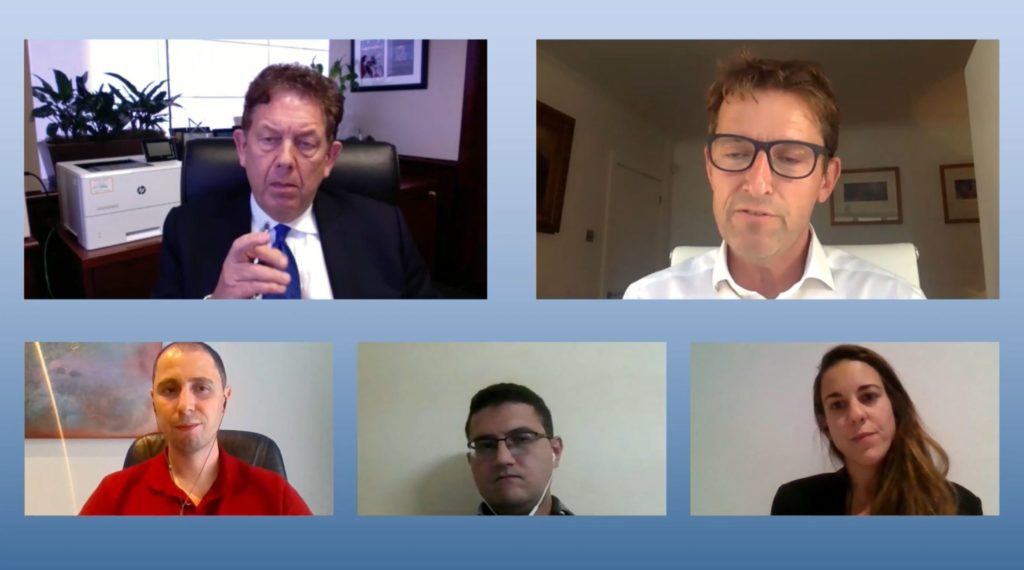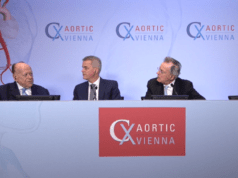
CX Aortic Vienna (8–11 September, livestreamed) hosted the second session in its “Best of CX and all abstracts” series on Thursday, highlighting the breadth of research taking place in the aortic space.
Opening the session, Filipe Fernandes (Lisbon, Portugal), an accredited vascular sonographer and lecturer at Lisbon School of Health Technology, presented a case study on median arcuate ligament syndrome (MALS), confirmed with vascular ultrasound. Fernandes described MALS as a rare abdominal vascular compression condition of the coeliac trunk, caused when the fibrous band that unites the diaphragmatic crura on either side of the aortic hiatus is atypically low positioned. Computed tomography angiography (CTA) is considered the gold standard diagnostic methods for MALS, with typical imaging characteristics including a “hook-like” focal stenosis at the origin of the coeliac trunk and an absence of arterial wall calcification.
“Vascular ultrasound is also one of the best initial tests to screen for MALS due to its non-invasiveness and the haemodynamic information that it provides,” Fernandes said, adding that it has the advantage of being a dynamic exam, allowing patients to be assessed in orthostatic and supine positions as well as in both phases of the respiratory cycle, being relevant because patients often have exacerbated symptoms in expiration. Following presentation of a case study demonstrating the usefulness of vascular ultrasound in a patient presenting with MALS, Fernandes concluded that vascular ultrasound constitutes an important and first-line imaging modality to diagnose MALS. “It allows a non-invasive haemodynamic and functional assessment of the coeliac trunk, its branches and of the superior mesenteric artery, obtaining a full spectrum of the haemodynamic repercussions of this condition, improving diagnostic confidence,” he summarised.
Wael Walid Sahyouni (Damascus, Syrian Arab Republic) presented on the topic of aortic aneurysms in Behcet’s disease. Behcet’s, or Silk Road disease, is a triad of aphtous oral and genital lesions, with recurrent eye inflammation, Sahyouni explained. The condition may complicate deep vein thrombosis, central and peripheral arterial aneurysms, or pseudoaneurysms. The causes of the condition, Sahyouni said, are not well known. He presented five cases of patients with Behcet’s disease, recorded between 2009 and 2015, explaining that MRI evidenced infrarenal aortic pseudoaneurysms.
The first choice of treatment for each of the patients was a stent graft, although one patient was treated surgically. “In the end, we can see that arterial aneurysms and pseudoaneurysms in Behcet’s disease are life threatening and challenging conditions,” Sahyouni said in summary. He added that stent graft procedures can be considered the treatment of choice for this pathology.
“Does age alone suffice for rejection of EVAR, or should it be offered to selected nonagenarians?” asked Carlota Fernandez Prendes, (Munich, Germany), in the third and final presentation of the session. Fernandez Prendes presented the findings of a propensity score analysis based on data from the American College of Surgeons national surgical quality improvement program (NSQIP), seeking to compare 30-day results of EVAR in nonagenarians versus non-nonagenarians. She said: “The last five to 10 years have seen a rise in EVAR of nonagenerians with 30-day mortality rates under 3%, and good mid- to long-term results.” Despite this, few studies have considered the outcomes of EVAR in nonagenarians.
Fernandez Prendes and colleagues found 30-day mortality rates were two times higher in nonagenarians compared to non-nonagenarians, without differences in short-term 30-day major adverse cardiovascular events (MACE). Additionally, on a subanalysis between elective and urgent procedures, the mortality rate was found to be up three times higher in elective procedures (3.2% vs 0.9%, p=0.09), though non significant on statistical analysis, and five times in urgent procedures (19.9% vs 4.1%, p=<0.01). This led Prendes to conclude that tailored nonagenarians can have good short-term results with tailored indications and a careful risk balance.
This session, and all other sessions from day three of CX Aortic Vienna, is available to view on demand. Click here to register and access the recording.













